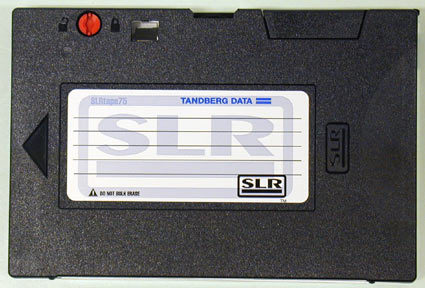The Last Resort: Streamer Technolgy Overview
8 mm / Mammoth / AIT
Magnetic tapes of 8 mm width originally were designed for video. Like DAT, 8 mm also employs Helical scan-based recording, though it offers much greater capacity.
Two formats among the 8 mm tapes are Mammoth - sponsored by ExaByte - and AIT, a solution backed by Sony and Seagate.
| Standard | Capacity | Maximum Transfer Rate |
|---|---|---|
| 8 mm | 3.5 GB | 533 kB/s |
| 8 mm | 5 GB | 1 MB/s |
| 8 mm | 7 GB | 1 MB/s |
| 8 mm | 7 GB | 2 MB/s |
| AIT-1 | 35 GB | 4 MB/s |
| AIT-2 | 50 GB | 6 MB/s |
| AIT-3 | 100 GB | 12 MB/s |
| S-AIT | 500 GB | 30 MB/s |
| Mammoth | 20 GB | 6 MB/s |
| Mammoth 2 | 60 GB | 12 MB/s |
Besides high capacities, the AIT system's key advantage is an additional memory chip on the streamer cassette, called MIC (Memory in Cassette), which contains a sort of table of contents for the magnetic tape. This eliminates many search processes when there is frequent access, and a direct jump to the desired position becomes possible. At the same time, AIT drives do not read sector information on the tape. Instead, they calculate the precise position on the basis of MIC information. This feature can also be used to ensure that the tape designated for each respective case is actually used.
For more information visit www.aittape.com .
SLR
SLR - this acronym stands for Scalable Linear Recording - is based on a robust design with few moving parts, thus ensuring a long-term reliability. From a technical standpoint, SLR is based on the QIC standard, and as in ADR (see description below), several heads are used. Prewritten servo tracks allow for a precise positioning of the heads. Also, Tandberg emphasizes the solution's high tolerance in case of temperature swings and changes in ambient humidity.
| Header Cell - Column 0 | Capacity | Maximum Transfer Rate |
|---|---|---|
| SLR3 | 1.2 GB | 300 kB/s |
| SLR4 | 2.5 GB | 300 kB/s |
| SLR5 | 4 GB | 380 kB/s |
| SLR7 | 20 GB | 3 MB/s |
| SLR50 | 25 GB | 2 MB/s |
| SLR60 | 30 GB | 4 MB/s |
| SLR75 | 38 GB | 4 MB/s |
| SLR100 | 50 GB | 5 MB/s |
| SLR140 | 70 GB | 6 MB/s |
For more information: www.tandberg.com .
Get Tom's Hardware's best news and in-depth reviews, straight to your inbox.

Patrick Schmid was the editor-in-chief for Tom's Hardware from 2005 to 2006. He wrote numerous articles on a wide range of hardware topics, including storage, CPUs, and system builds.
